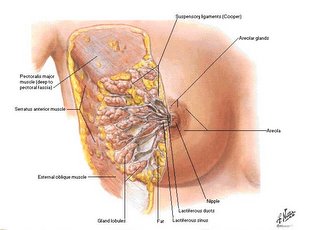Breast Reconstruction Decision
With today's advanced surgical procedures, most women who undergo surgery for breast cancer are candidates for breast reconstruction. There are various types of reconstruction, and they are available to women who have had a mastectomy, partial mastectomy, or lumpectomy.
The decision of whether to have breast reconstruction arises at a very emotional time usually at the same time a woman learns she has breast cancer and needs surgery. It is a time when many questions come up about reconstruction, the most common of which are answered here briefly:
Is age a factor? As long as a woman is in good general health and chooses a procedure that is compatible with her physical condition, age is usually not a factor. Breast reconstruction is frequently done for women in their 70s.
Who should not have breast reconstruction? Women who are in poor general health, who have psychological problems that would be exacerbated by the surgery, or who have severe diabetes, Alzheimer's disease, a recent stroke nine-art attack, or severe lung disease usually should not have breast reconstruction.
Do I have to make a decision about having reconstruction before I have the mastectomy? No, but the best time to think about breast reconstruction and to consult with a reconstruction surgeon is before you have your mastectomy. Depending on the type of mastectomy you have, you may be able to undergo immediate reconstruction while you're still on the operating table. There are advantages and disadvantages to having immediate reconstruction (see below). Not all mastectomies lend themselves to this approach, however, which means it is important for you to understand all your options prior to mastectomy. Then if you choose to delay reconstruction, you at least were given the opportunity to make an informed decision.
Are there any health conditions that could have a negative effect on reconstruction? Women who smoke are more susceptible to postoperative infections and slow healing, so if you smoke it is best to quit before surgery. Obesity is associated with an increased risk of pneumonia, blood clots in the legs, and complications related to anesthesia. The results of both types of reconstruction (implant and flap, both described below) are frequently unsatisfactory in obese women.
How many operations are involved in breast reconstruction? Most breast reconstructions can be completed in two operations. The majority of the work is done during the first procedure, and the second usually involves reconstructing the nipple and areola, improving symmetry of the breasts, and making any minor adjustments.
Does breast reconstruction cause cancer? There is no evidence that breast reconstruction causes or contributes to the development of cancer.
How will my breast reconstruction look in 5 to 10 years? The long-term results of breast reconstruction are different for each woman and depend on the type of procedure you have, your weight, and whether you experience intervening infections or other breast problems.
Immediate Reconstruction: Yes or No?
Once you know you must undergo mastectomy, it is usually difficult to also have to think about reconstruction. This is the time to surround yourself with supportive individuals, be they family, friends, health care providers, or breast cancer support group members. It is also the time to educate yourself about reconstruction. This is a way to take charge of your health, to have some control over the direction your life is taking.
When it comes to the question of whether you are a candidate for immediate or delayed reconstruction, ask your breast and reconstruction surgeons to explain why they are recommending one or the other. The primary factor that determines the best approach is whether the cancer has affected the lymph nodes and to what extent. Chemotherapy usually is not started until 2 or 3 weeks after mastectomy to allow for healing. If your surgeons believe you must begin chemotherapy immediately to get the best possible outcome, they may recommend delaying reconstruction.
Combining mastectomy and reconstruction adds days and occasionally weeks to the healing period, which would significantly delay chemotherapy and possibly have a negative impact on your prognosis. If your surgeons say immediate reconstruction is an option for you, you must decide if it's best for you.
To help you make a decision, it may help to look at the pros and cons (outlined below) and to discuss your concerns with those close to you. The best candidates for immediate reconstruction are women with early breast cancer who are in good general health, women with small breasts, and those who need both breasts reconstructed. However, even if you are ready physically, you may not be mentally or emotionally prepared. In that case, it may be better to delay reconstruction. Advantages and Disadvantages of Immediate Reconstruction
PROS
· Avoiding an additional surgical procedure.
· One less procedure means less chance of complications.
· Less recovery time needed.
· Costs less money
· Less time to dwell on the cancer.
· Less negative impact on body image.
· Faster opportunity to get on with your life.
CONS
· Less time to gather information to make an informed decision. · Surgical procedure is longer, which increases the chances of complications.
· Possible dissatisfaction with the results
· May delay mourning period for the missing breast


